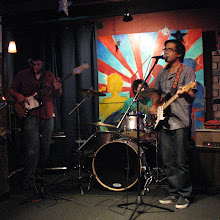Today was the first day of electric guitar overdubs for "The Drifter," and I was amped... no pun intended. After allowing both guitar amplifier and compressor to warm up (about an hour), placing the microphone at just the spot where the sweetest sounds seemed to be oozing out the amplifier, the guitar was tuned, and I was ready for a take. One take turned into two, three, four, then five. Before I knew it I was on take fifteen and I still wasn't performing the way I wanted to. I wasn't locked with the drums and just wasn't strumming very precisely. Sloppy, sloppy, sloppy.
So I come to lesson one in guitar recording:
If it's not happening, step away from the guitar.
My hand was fatiguing fast and I was losing inspiration. Some people work very well plugging away at something until it suddenly works. I on the other hand cannot work this way. I can try only up to a certain point until I become demoralized. So in this case I just put down the guitar, put the amp on standby, and went out for a 15 minute walk.
Once I came back, my fretting hand was rested and I had a clear enough head to dive headlong back into the recording process. Before I knew it, in less than two hours I had laid down over ten tracks of rhythm and lead/riffing guitar parts. What a difference a positive attitude and a clear head can make.
So now onto the real purpose of the blog... fun tricks and tips for the electric guitar that I've come across in my little experience as an engineer.
Stereo Width: Using Different Guitars
| Two Fender classics: Stratocaster (left) and Jazzmaster (right) |
I often like to record at least two tracks (two separate takes) of electric guitar playing the same exact thing to give the impression of thickness and substance to a guitar sound. My favorite method is to employ two different guitars with slightly different sonic characters to add a lush, three-dimensional sound. I start with a mellow or dark sounding guitar, which I then balance by recording a bright or chimey guitar. In the case of "The Drifter," I employed first a Fender Jazzmaster (mellow sound) complemented by a Stratocaster (brighter sound). This works too if you contrast humbucker equipped guitars with single coil guitars, or simply by using guitars that are brighter in character (i.e. Danelectro) with guitars that are darker in character (i.e. Gretsch).When panned hard left and right in the mix, the stereo field remains wide despite the similarities in performance and chord changes simply because the sonic character of the two guitars are different.
Of course, no two guitars are exactly the same, so you can play around with whatever two guitars you have lying around to get the same stereo-widening effect.

No comments:
Post a Comment